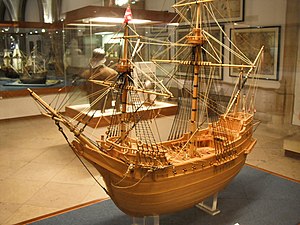
Back Madre de Dios (barco) Spanish Madre de Deus (nave) Italian Madre de Deus (nau) Portuguese Madre de Deus (1589) Ukrainian
 Model of the Portuguese carrack Madre de Deus, in the Maritime Museum (Lisbon)
| |
| History | |
|---|---|
| Name | Madre de Deus, Mãe de Deus and Madre de Dios |
| Builder | Lisbon shipyards, Kingdom of Portugal |
| In service | 1589 |
| Out of service | 1592 |
| Fate | Captured by the English |
| General characteristics | |
| Class and type | Carrack |
| Displacement | 1600 tons |
| Tons burthen | 900 tons |
| Length | 30.48 m (100 ft) keel, 50.29 m (165 ft) (beakhead to stern)[1] |
| Beam | 14.27 metres (46 ft 10 in) |
| Draught | 9.45 m (31 ft)[α] |
| Sail plan | Full-rigged, main mast is 36.88 m (121 ft) high |
| Complement | 600–700 men |
| Armament | At least 32 guns |
Madre de Deus (Mother of God; also called Mãe de Deus and Madre de Dios, referring to Mary) was a Portuguese ocean-going carrack, renowned for her capacious cargo and provisions for long voyages. She was returning from her second voyage East under Captain Fernão de Mendonça Furtado when she was captured by the English during the Battle of Flores in 1592 during the Anglo–Spanish War. Her subsequent capture stoked the English appetite for trade with the Far East, then a Portuguese monopoly.
- ^ Hakluyt, Richard (1904). The Principal Navigations, Voyages, Traffiques & Discoveries of the English Nation Made by Sea or Over-land to the Remote and Farthest Distant Quarters of the Earth at Any Time within the Compasse of these 1600 Yeeres. Vol. 7. Glasgow: J. MacLehose and Sons. pp. 116–117 – via Internet Archive.
- ^ Jordan, Brian (2001). "Wrecked ships and ruined empires: an interpretation of the Santo António de Tanna's hull remains using archaeological and historical data". International Symposium on Archaeology of Medieval and Modern Ships of Iberian-Atlantic Tradition: 301–316. Retrieved 2022-03-26 – via Academia.edu.
Cite error: There are <ref group=lower-greek> tags on this page, but the references will not show without a {{reflist|group=lower-greek}} template (see the help page).